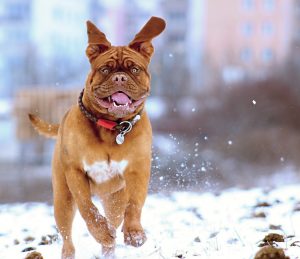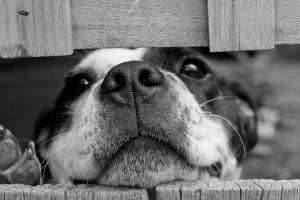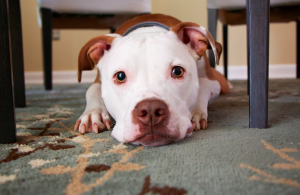Not all dogs are fortunate enough to grow a thick winter coat or fur around the pads of their feet when the weather starts to get colder. Short-haired dogs are often not genetically suited to live in extremely cold climates and are, therefore, more prone to cold weather-related conditions such as frostbite or hypothermia. Our beloved pit bulls have wonderfully short, low-maintenance hair that can pose a challenge in the winter months. Read on for tips on how to protect your dog from the elements.
- Sweaters add an extra layer of warmth to your dog’s body, somewhat mimicking the thick winter coat that other long-haired dogs are able to grow. Sweaters are great for your dog to wear indoors or outside when it’s not raining or snowing (a wet sweater will only make them colder). Make sure the garment fits properly in the neck, chest, and shoulder areas and isn’t too tight. Also be sure that the sweater isn’t covering the dog’s elimination area so that they can still “go” freely. If you’re scoffing at the idea of dressing your dog, keep in mind that dogs are sensitive to temperature changes just as people are, and might need a little extra warmth to be
 comfortable.
comfortable. - While sweaters are ideal for indoors or dry conditions outdoors, wet weather may require something a bit more heavy duty. A thick, durable, insulated winter jacket may be just what your dog needs to enjoy outside activity in the rain or snow. As with sweaters, be sure the jacket fits properly and is not covering the elimination area.
- Booties can help protect the pads on your dog’s feet from getting frostbite. Many long-haired breeds have evolved to grow heavy fur on their feet to protect their pads from the cold, but pit bulls (and other short-haired breeds) do not have that option. Dog booties are especially important to consider if you live in an area with snow. Some dogs don’t like wearing booties, however, so be sure to clean off their bare paws after they walk outside in the snow. Antifreeze and other snow removal chemicals on the ground can be toxic if ingested, and salt can become an irritant.
- Keep your dog feeling warm and secure with a heating pad or heated blanket for his/her bed. Keep the heated pad or blanket on one of the low-medium settings to avoid overheating. Heating pads aren’t generally too expensive (around $20-$40 each) but if you don’t want to buy one, give your dog extra blankets to snuggle into and keep their bed away from drafty doors or windows.
- Bathe your dog inside with warm water and make sure he/she is completely dry before going outside. Your dog actually may require fewer baths in the winter months, due in part to less physical activity outside, but if you do give your dog a bath, remember that it takes longer for their fur to dry in cold weather. Giving him/her a quick blow dry may do the trick!
- Indoor dog parks are a great option for exercise in the winter months. It will give your dog a chance to release some pent-up energy and socialize with other dogs while staying safe from the elements. If there isn’t an indoor dog park in your area, some doggy daycare centers will allow playtime sessions at their indoor facilities. Exercise is still important, even in cold weather!


 It’s no secret that owning a dog comes with responsibility. But in many ways, owning a pit bull requires even more responsibility. Pit bull owners face some tough challenges, like breed stigmatization, discrimination, and bias. It’s not for everyone, but being a pit bull or bully breed owner can be one of the most rewarding experiences you could have.
It’s no secret that owning a dog comes with responsibility. But in many ways, owning a pit bull requires even more responsibility. Pit bull owners face some tough challenges, like breed stigmatization, discrimination, and bias. It’s not for everyone, but being a pit bull or bully breed owner can be one of the most rewarding experiences you could have.